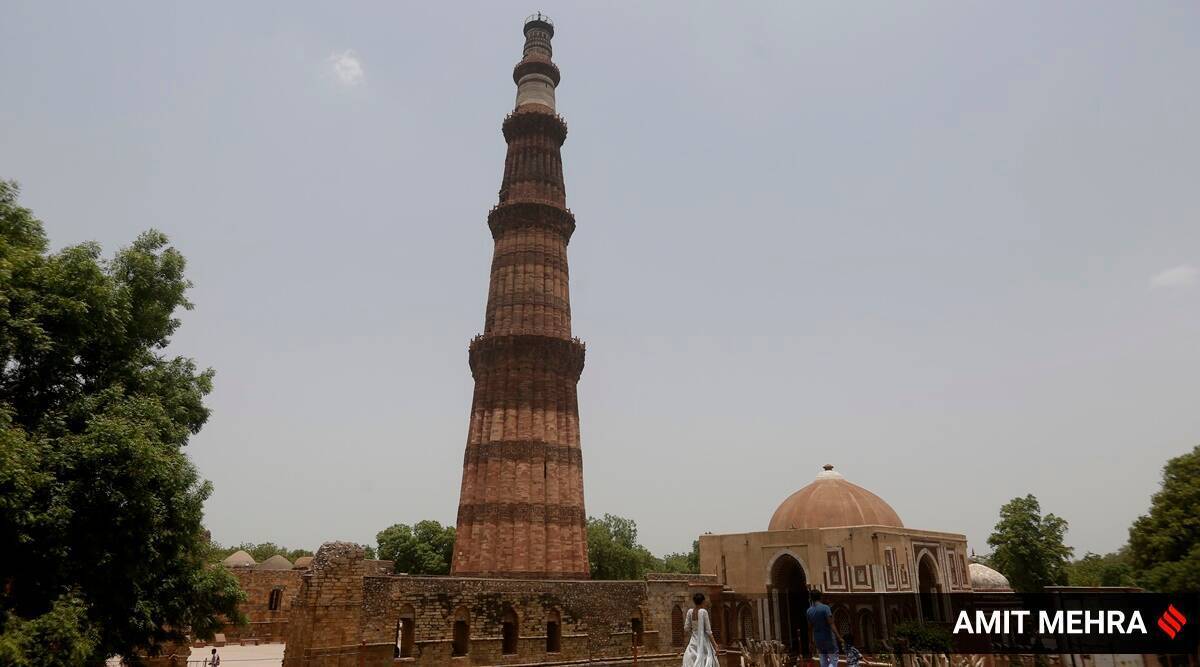 The Qutub Minar in Delhi (Express File Photo)
The Qutub Minar in Delhi (Express File Photo)With the Archeological Survey of India (ASI) maintaining that the Qutub Minar complex’s status cannot be changed to allow worship, a Delhi court Tuesday reserved till June 9 its order on a plea seeking restoration of Hindu and Jain deities inside the premises.
Additional District Judge Nikhil Chopra flagged two key aspects in the case — the right to worship and the character of the structure. The district court questioned how one can claim a legal right for restoration for something that happened 800 years ago.
The plea challenged a lower court’s dismissal of an application — filed on the behalf of Hindu deity Vishnu, Jain deity Tirthankar Rishabh Dev and others — that sought the restoration of “27 Hindu and Jain temples” at the Quwwat-ul-Islam mosque inside the Qutub complex.
Best of Express Premium
At Tuesday’s hearing, the ASI opposed the plea, arguing that the mosque’s character was frozen after it came under the protection of the Ancient Monuments and Archaeological Sites and Remains (AMASR) Act, 1958.
In a reply filed Monday, it stated that even though architectural images of Hindu and Jain deities were used in the construction of the complex, revival of worship cannot be allowed there as it was “not practiced at the time of protection of the monument”. “A fundamental right cannot be availed in violation of any status of the land,” it said.
On November 29, 2021, a civil judge, while dismissing the plea, had observed that wrongs committed in the past “cannot be the basis of disturbing (the) peace of our present and future”.
Advocate Subash C Gupta, who appeared for the ASI, told the court Tuesday that there is no ground for interfering with the lower court’s judgment.
“Character of a place is determined on the date the monument comes under the purview of the AMASR Act. The character once frozen as that in the monument cannot be changed,” Gupta argued, invoking a Delhi High Court ruling.
Advocate Hari Shankar Jain, who addressed arguments on behalf of the petitioners, said that the Quwwat-ul-Islam mosque was constructed after 27 temples were demolished and that no prayers have been offered at the mosque in the past 800 years.
Stressing that the petitioners just wanted the restoration of deities and the conduct of puja, and not “demolish anything”, he submitted: “When there was a temple in existence much before the mosque, why can’t it be restored?”
The judge said: “What is the legal right? Assuming it was invaded, demolished, some structure raised, let us assume it was not being used by Muslims. The important question is, can you now claim it to be restored under what basis? Now you want this monument to be turned into a temple calling it restoration, my question is how would you claim that the plaintiffs have a legal right assuming it existed about 800 years back?”
Relying on Section 16 of the AMASR Act, Jain told the court: “If it is a Hindu temple, why can’t it be permitted for that? The law says so. Once a deity property, it’s always a deity property. It will survive forever. The divinity of a deity never vanishes. After the demolishing of a temple, it will not lose its character, divinity or sanctity.”
The court said: “Deity is surviving for the last 800 years without worship. Let it survive like that.”
The court also said the “existence of the idol is not in dispute” and asked if the “right to worship is an established right, whether it’s a constitutional or any other right, and what remedies, if any, are available with this right?”
Jain told the court that he has the right to worship under Article 25 of the Constitution.
Gupta rebutted this, saying: “Yes, fundamental right exists but it’s not absolute and therefore (the) court has found that this right is not available in this case.”
He said the inscriptions on the Quwwat-ul-Islam mosque state that the “mosque was built with the remains of 27 temples but nowhere it is mentioned that the material for construction were received by demolishing temples”.
The ASI reply on Monday stated: “Fundamental right cannot be availed in violation of any status of the land. The basic principle of protection/conservation is not to allow starting of any new practice in a monument declared and notified as a protected one under the Ancient Monuments and Archaeological Sites and Remains (AMASR) Act, 1958. Revival of worship is not allowed wherever it is not practiced at the time of protection of a monument.”
The ASI stated that there are a number of sculptures within the Qutub complex but it would be “contrary to the provisions of the AMASR Act to agree with the contention of the respondents or any other person claiming a fundamental right to worship in this centrally protected monument”.
The ASI submitted that it was a fact that architectural images of Hindu and Jain deities were used in the construction of the Qutub complex. “This is very clear from the inscription at the Quwwat-ul-islam mosque (which) clearly stated that the cloisters were erected with carved columns and other architectural members from the 27 temples,” it submitted.
- The Indian Express website has been rated GREEN for its credibility and trustworthiness by Newsguard, a global service that rates news sources for their journalistic standards.

